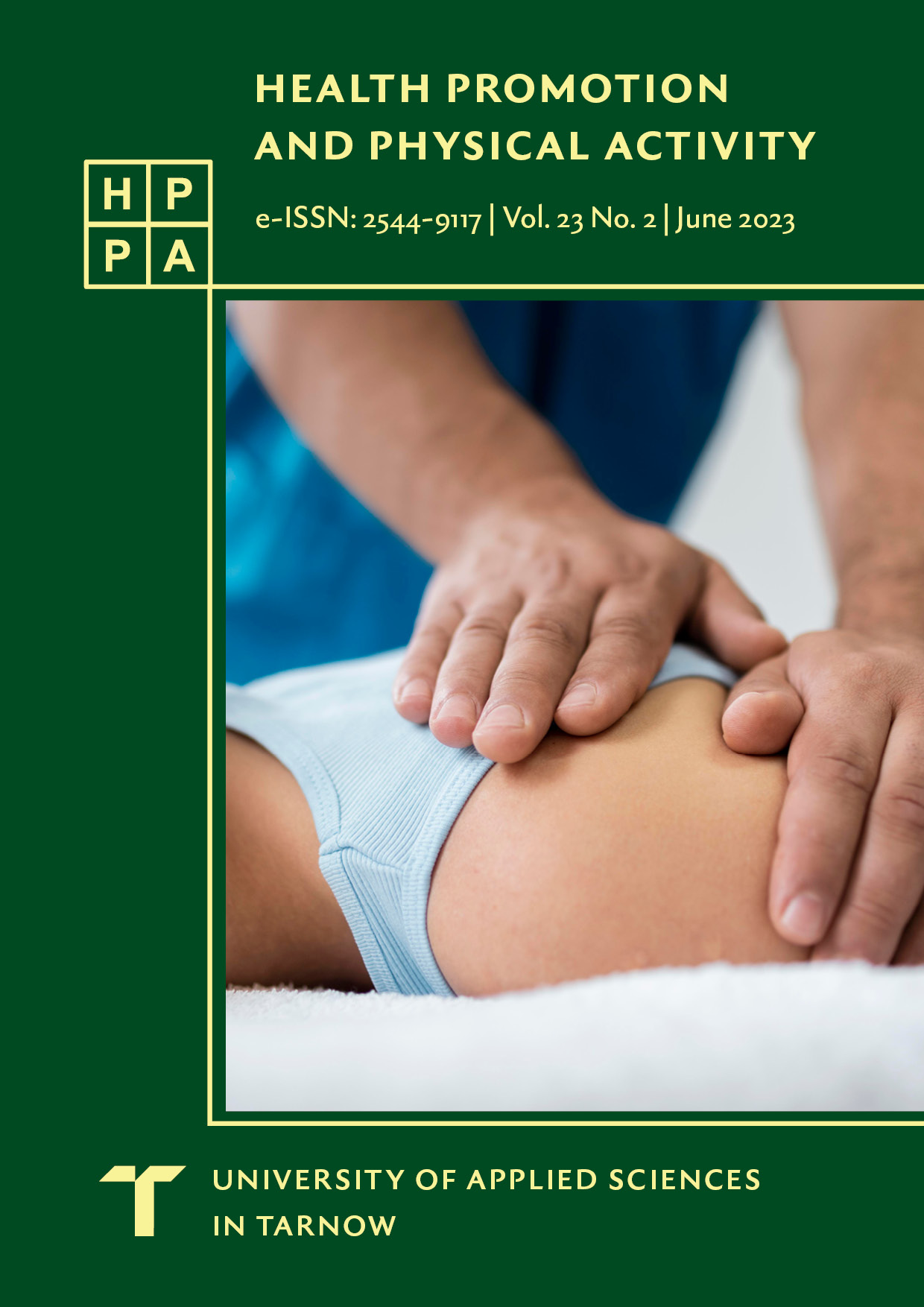Evaluation of therapeutic management in women with lumbar spine pain complaints
DOI:
https://doi.org/10.55225/hppa.512Keywords:
pain syndromes, rehabilitation, general mobility exercises, stabilization exercisesAbstract
Aim of the study: To evaluate the effects of two different modes of improvement on the level of perceived pain, spinal mobility, lumbar spinal motion control and limitations in activities of daily living in women aged 51–62 with lumbar spine pain.
Material and methods: The study included a group of 31 women between the ages of 51 and 62. The subjects were divided into 2 groups. Group I (FK) received physical therapy treatments and general gymnastics, while group II (FS) received physical therapy treatments and exercises using a PBU stabilizer. The project covered a period of 10 treatment days excluding Saturdays and Sundays. Before and immediately after the rehabilitation, tests of flexion and extension control in the L-spine, active knee joint flexion test, Schober test were performed, and the NRS scale was used scale and QBPDS scale.
Results: After the applied rehabilitation, a significant reduction in the level of perceived pain and improvement in spinal mobility in the direction of flexion were observed in both groups. In the FS group, there was also a significant improvement in lumbar flexion control and better lumbar spine control during the active knee flexion test. In addition, a reduction in disability as measured by the QBPDS scale was noted.
Conclusions: The use of comprehensive rehabilitation brings significant improvements in terms of pain reduction and improvement in lumbar spine mobility in the flexion direction. A two-week exercise program using a stabilizer appears to yield significantly better results in terms of lumbar flexion control as well as better lumbar control during the active flexion test of both knee joints. And this, in turn, may affect the results obtained using the QBPDS scale among FS subjects.
Downloads
References
Sous M, Stryla W. Ocena gibkości kręgosłupa u chorych z zespołami bólów części lędźwiowej kręgosłupa na tle przepukliny jądra miażdżystego. Postępy Rehabilitacji. 1999;13(3):45-55. Google Scholar
Kołodziej K, Kwolek A, Rusek W, Przysada G, Szpunar P. Korelacje wskaźnika symetryczności obciążenia kończyn dolnych i nasilenia bólu u pacjentów z zespołem bólowym kręgosłupa lędźwiowo-krzyżowego rehabilitowanych szpitalnie. Prz Med Uniw Rzesz. 2005;3:234-236. Google Scholar
Kwolek A, Korab D, Majka M. Rehabilitacja w zespołach bólowych dolnego odcinka kręgosłupa: zasady postępowania. Postępy Rehabilitacji. 2004;18(3):27-31. Google Scholar
Depa A, Wolan A, Przysada G. Wpływ rehabilitacji na zmianę ruchomości kręgosłupa oraz subiektywnego odczuwania bólu u chorych z zespołem bólowym Google Scholar
w odcinku lędźwiowym. Prz Med Uniw Rzesz. 2008;2:116-124. Google Scholar
Kwolek A. Rehabilitacja w neuropatiach i zespołach nerwów rdzeniowych. In: Kwolek A, ed. Rehabilitacja medyczna. T. 2. Wrocław: Edra Urban & Partner; 2017:129-146. Google Scholar
Comerford M, Mottram S. Kinetic Control. Ocena i reedukacja niekontrolowanego ruchu. Hadała M, ed. for Polish ed. Wrocław: Edra Urban & Partner; 2021. Google Scholar
Gałuszka G, Janiszewski M. Fizykoterapia w leczeniu zespołów bólowych dolnego odcinka kręgosłupa. Medycyna Manualna. 2003;7(3-4):37-41. Google Scholar
Gross JM, Fetto J, Rosen E. Badanie układu mięśniowo-szkieletowego. Kujawa J, ed. for Polish ed. Warszawa: Wydawnictwo Lekarskie PZWL; 2016. Google Scholar
Buckup K, Buckup J. Testy kliniczne w badaniu kości, stawów i mięśni. Warszawa: Wydawnictwo Lekarskie PZWL; 2022. Google Scholar
Bac A, Jankowicz-Szymańska A, Liszka H, Wódka K. Diagnostyka narządu ruchu w fizjoterapii. Wrocław: Edra Urban & Partner; 2022. Google Scholar
Kopec JA, Esdaile JM, Abrahamowicz M, et al. The Quebec Back Pain Disability Scale: conceptualization and development. J Clin Epidemiol. 1996;49(2):151-161. doi: 10.1016/0895-4356(96)00526-4. DOI: https://doi.org/10.1016/0895-4356(96)00526-4 Google Scholar
Mikołajczyk E, Jankowicz-Szymańska A, Janusz M, Bakalarz J. Wpływ tradycyjnej fizjoterapii oraz metody Medical Taping na dolegliwości bólowe i stopień dysfunkcji pacjentów z zespołem bólowym odcinka lędźwiowo-krzyżowego kręgosłupa. Prz Med Uniw Rzesz Inst Leków. 2012;2:223-237. Google Scholar
Lisiński P, Wołoszyk M. Zastosowanie całkowitego wskaźnika bólu w ocenie leczenia fizykoterapeutycznego rwy kulszowej. Fizjoterapia Polska. 2005;5(3):305-312. Google Scholar
Koumantakis GA, Watson PJ, Oldham JA. Trunk muscle stabilization training plus general exercise versus general exercise only: Randomized controlled trial of patients with recurrent low back pain. Phys Ther. 2005;85(3):209-225. DOI: https://doi.org/10.1093/ptj/85.3.209 Google Scholar
Goldby LJ, Moore AP, Doust J, Trew ME. A randomized controlled trial investigating the efficiency of musculoskeletal physiotherapy on chronic low back disorder. Spine (Phila Pa 1976). 2006;31(10):1083-1093. doi: 10.1097/01.brs.0000216464.37504.64. DOI: https://doi.org/10.1097/01.brs.0000216464.37504.64 Google Scholar
Kujawa J, Pyszczek I, Talar J, Janiszewski M. Porównawcza ocena skuteczności przeciwbólowej wybranych metod fizjoterapeutycznych w zespole bólowym dolnego odcinka kręgosłupa. Fizjoterapia Polska. 2001;3:271-279. Google Scholar
Łukowicz M, Weber-Zimmermann M, Ciechanowska K, Szefer A. Efekt włączenia sonoterapii do postępowania kinezyterapeutycznego w zespołach bólowych odcinka lędźwiowego kręgosłupa. Acta Bio-Optica et Informatica Medica. Inżynieria Biomedyczna. 2009;15(1):40-43. Google Scholar
Ajimsha MS, Daniel B, Chithra S. Effectiveness of myofascial release in the management of chronic low back pain in nursing professionals. J Body Mov Ther. 2014;18(2):273-281. doi:10.1016/j.jbmt.2013.05.007. DOI: https://doi.org/10.1016/j.jbmt.2013.05.007 Google Scholar
Dilekçi E, Özkuk K, Kaki B. The short-term effects of balneotherapy on pain, disability and fatigue in patients with chronic low back pain treated with physical therapy: A randomized controlled trial. Complement Ther in Med. 2020;54:102550. doi: 10.1016/j.ctim.2020.102550. DOI: https://doi.org/10.1016/j.ctim.2020.102550 Google Scholar
Downloads
Published
How to Cite
Issue
Section
License
Copyright (c) 2023 Agnieszka Zbylut, Katarzyna Wódka

This work is licensed under a Creative Commons Attribution-ShareAlike 4.0 International License.









